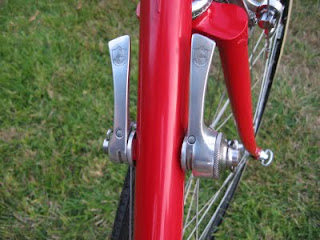While the name Suntour does not necessary equate with vintage Campagnolo, freewheels certainly do. When I rebuilt my
Specialized Allez I was thrust into the world of freewheels (previously I made due wit

h the 7 speed Regina freewheel and 7 speed Syncro Shifters). I decided to de evolve the bike to a 6 speed and ended up with several Suntour New Winner Ultra freewheels, 13x21 cogs and 13x24 cogs; and a Suntour New Winner Pro in 13x22 (and a couple of Shimano 14x28).
When I put my
Vintage Cross Bike together I also bought a Suntour "Perfect" freewheel with 14x26 cogs.
Below right is one of the New Winner FWs; the 13x22, The 13x24 currently resides on the Allez.

Unfortunately the Perfect 14x26 skipped badly when in the big ring as a result of the 2nd, 3rd and 4th cogs being worn. Below left are the cogs; it is quite difficult to determine if a freewheel is worn simply by sight.

which really don't look so bad. In the short time I used the the freewheel, I discovered the 14x16 setup was almost perfect for my riding. I also discovered that 14x26T freewheels are few and far between. You can find them on worn for ultra cheap freewheels. or in good condition for $100. The Perfect was one of Sun Tour's first imported freewheels and the lowest on the food chain; the New Winner came later and are near the top. But I figured there must be some similarity in construction so I concocted a plan to use parts from the Perfect to made the New Winner a 14x 26 freewheel.
I took the two apart by screwing the largest ring into my work bench and used a chain whip.


The New Winner is on the left and is constructed much like a cassette, however there are two size rings; 2 large (22 and 20), 3 middle 18, 16, 14 and a third size lock ring (13). The Perfect is on the right. It has the same size large rings only there are 4 (26,23,20, 18) and two smaller cogs (the same size as the middle rings of the New Winner, but they are threaded(16 and 14). My first thought was to simply replace the New Winner big cogs (22/20) with the Perfect (26/22); This went together okay, but the 4 tooth gaps between the 18/22 and 22/26 were too much. So I ordered some cogs from a web store named
Loose Screws. As the site explains, the cogs are numbered (click on the picture below).

The New Winner cogs markings were a little different so I knew which cogs I wanted .It would have been a short order if Loose Screws had all the cogs, but they didn't. What I wanted was a 14T "S" threaded cog lockring, a 16T "F" cog and a 20T "A". What I ended up with was the14T "S", and a 21T "A" (the 21 "A" is also black and has the Suntour Accushift ramps and tooth configurations). I also saw a problem with the second cog on the New Winner so I ordered a 16T "L" cog hoping I could use it (turns out I could, but not in the way I planned. When the cogs came and I put the freewheel together the issue with the "F" cog fully revealed itself.
My plan was to create a 14/16/18/20/23/26 freewheel, so I need the 14T and a middle size 20T cog to make it work; with the 21T it would still be a 14/16/18/21/23/26, which I saw as workable. The problem was the second cog had a strange configuration.
As you can see the upper is a standard medium size 16T cog and the lower is still medium size but a F cog configuration. If you click on the first picture you can see how the F cog normally fits in the freewheel splines.

If you click on the picture below the first you can see how the 16T A cog does not engage the splines very well and when I tried to assemble it this way, the cog would tilt top one side. The 16T L cog that I hoped would solve the problem was something entirely different and had the same threading as the lockring. What I ended up doing is cutting up the cog with a Dremel and creating a cog similar to the F. The work is a little rough but it fit great

(see below)


And below is the final product. I rode on it today and it worked perfectly. Yes it was a lot of work, but I learned a lot, slew a dragon and have a working 14x26 freewheel, all at the same time! Happy riding!


















































